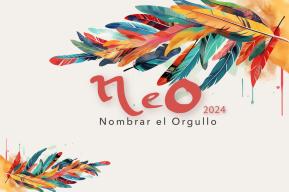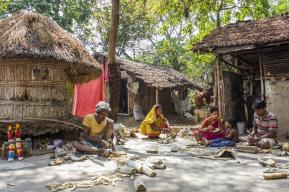Project
Biodiversity Conservation and Sustainable Natural Resource Management (BIOCOM)

Budget: +5M$
Location: Marojejy National Park, Andohahela Nationa Park and Montagne des Français Nature Reserve of Madagascar
Dates of implementation: 02-03-2020
Donor: Korea International Cooperation Agency (KOICA).
The Rainforests of Atsinanana provide residents with crucial ecosystem services. The Marojejy and Andohahela Forest landscape in north-eastern and south-eastern Madagascar represents one of the largest remaining intact expanses of humid forest in the country’s biologically rich Eastern Rainforest Biome. Covering a total surface of 136 300 ha (distributed across a Category II protected area and its surrounding buffer zone), Marojejy and Andohahela forests are a key biodiversity stronghold and a vital bridge maintaining long-term connectivity between protected areas to the south and north.

The Montagne des Français forests are a dry deciduous formation and the structure differing based on substrate and topographic setting and cover 6 141 ha. The vegetation structure on the upper portion of Montagne des Français is a flat karstic formation with a distinct vegetation type including mixture of dry forest, short thicket, and rupicolous vegetation. This protected area faces many threats such as the extensive conversion of forest trees to charcoal, mostly for sale in Antsiranana; illicit cutting of forest trees for the lumber market in Antsiranana; slash-and-burn agriculture (tavy, locally known as tetik’ala in Malagasy); lemur hunting for bushmeat; and poisoning of lemurs, specifically Eulemur coronatus, with herbicide laden fruits placed in the forest.

Project Rationale
The protected natural ecosystems of these areas reduce greenhouse gas (GHG) emissions through carbon storage and capture. Thus, it offers a buffer against extreme events. These protected areas help people adapt to the effects of climate change by preserving the essential environmental services they depend upon. Also, these sites are a source of income for communities through micro-projects and conservation and ecotourism activities.
However, these values are under threat from anthropogenic influences including slash and burn agriculture, clearing for pastures, intensive bushmeat hunting, small scale or illegal logging of rose hood and illegal mining. Greenhouse gas emissions are generated predominantly by the conversion of forests to agricultural lands using slash and burn techniques and the increasing rates of forest conversion are a significant threat to the biodiversity, the carbon stockage function of the forest and the viability of downstream watershed services in Marojejy, Andohahela and Montagne des Français that vital to local and regional economies. The area’s natural resources and its 300,000 rural, poor, local human population are also highly vulnerable to climate change. Severe cyclone activity and flooding results in destroying forests and crops and causes severe soil loss on erosion prone hillsides. Increased variability in annual rainfall affects household subsistence agricultural practices and increases dependence on natural resources found within the forest landscape.
These pressures, such as illegal logging and poaching, threaten the integrity of these sites and which led to the sites’ inscription on the UNESCO List of World Heritage in Danger in 2009. Madagascar is experiencing recurrent political instability, which has led to impoverishment and dependence of the population on natural resources as well as growing insecurity and generalized poor governance. All of this has a negative impact on the World Heritage property and is a major challenge to its sustainability.
This project will contribute to the sustainability of the property through actions involving local communities, managers and local management authorities. The establishment of local "dina" contracts with local communities facilitates the management of conflicts and offenses. Accompanying measures, including the creation of income-generating activities or livelihood activities can lead to financial self-sufficiency and the reduction of dependence on natural resources. All of these fits into a broad context of sustainable development that takes into account the importance of ecological services provided by ecosystems within the World Heritage property. This complementarity of conservation and development remains a major challenge for a poor country.
On the development plan, primary schools have teachers, but programs deserve additions to develop education for sustainable development. Lastly, dropouts are frequent in primary and secondary schools, whereas vocational training centers are non-existent in the area. Women are the most disadvantaged and do not always benefit from the opportunities generated by the presence of these sites.
Pilot Sites
Marojejy National Park located in Northeast Madagascar on the sacred mountain’s slopes inside Sava Province. The National Park of comprises 55,500 hectares (137,144 acres) of land and protects the entire Marojejy Massif. The forests, ranging from low altitude rain forest through to high altitude montane scrub, harbour an impressive list of plants and animals.

Andohahela National Park in south-east Madagascar, is remarkable for the extremes of habitats that are represented within it. The park covers 760 km² of the Anosy mountain range, the southernmost spur of the Malagasy Highlands and contains the last humid rainforests in the southern part of Madagascar.

The Montagne des Français Nature Reserve protects deciduous dry forest characteristic of the north of Madagascar. Much of the forest is on a calcareous massif that has been eroded into karst formations known locally as Antsingy. The forested area ranges from 100–450 metres above sea level. This mountain is thought to receive more rain than the surrounding area (Antsiranana receives approximately 1000mm precipitation annually) which explains the lush vegetation in an otherwise very dry bioclimatic zone.
Beneficiaries
Local communities in the periphery of Marojejy, Andohahela and Montagne des Français protected areas are the direct beneficiary group.
The project set up participatory structures to enable local communities located in the periphery of Marojejy, Andohahela and Montagne des Français protected areas to contribute to its sustainable management and reinforced organizational capacities of involved communities. Indeed, the project will support the transfer of forest management authority to local communities in the protection zone of the protected area and will train community members in sustainable management of natural resources.
Overall Objective
The main objective is the conservation, advance research and promote wellbeing of the local community. The project considers the restoration and sustainable enhancement of these protected areas by local stakeholders and the maintenance of biological diversity.
Through this project, deforestation and forest degradation will be reduced in an efficient and sustainable manner, while directly supporting activities that help local communities reduce their vulnerability and improve their adaptability.
Protected areas are well monitored, long-term conservation is assured, and research advances as needed.
At the same time, the project will promote economic alternatives to unsustainable and destructive use of forest resources. Equally, the project will ensure that any benefits flowing from the protected area are equitably and transparently shared with the communities of the protection zone.
Implementation Strategy
The project shall be in 3 components:
- The proposed activities will ensure the conservation of biodiversity and natural resources of the protected areas. Reduction of the pressures and threats to ecological functions and biodiversity of Marojejy, Andohahela and Montagne des Français forests through control and surveillance activities, ecological monitoring, research and restoration of deforested land inside these forests. Strengthening management, support to managers (equipment). Staffing of office equipment and materials contributes to the efficient running and management of the project.
- At the same time, it is necessary to set up alternative activities to limit the extraction of natural resources for subsistence needs of communities neighbouring these protected areas. Local communities exert various pressures on the forests within these three protected areas despite the regulations in place due to the lack of compensation measures during their expulsion from the park. Thus, alternative activities must be implemented in order to improve the income of the communities bordering the protected areas and reduce the pressure on natural resources. The objective is to diversify the sources of income of the communities to improve their livelihoods, thus, leading to the durable conservation of the sites.
- Sustainable development education programs, in which environmental education and awareness play an important role in the conservation of biodiversity. In addition, local people will be educated and sensitized to environmental issues, so that they can develop attitudes, skills and reflexes to protect the environment and promote conservation activities.
Project Expected Outcome
- A reduction of deforestation and an increased area of eco logically intact forest and the initial phases of restoration of degraded habitats. Protected areas are well monitored, long-term conservation is assured and research advances as needed
- The parks are effectively managed and protected, sustainable livelihoods (alternative income generating activities) of the local community developed and
- Increased engagement of youth and women in natural resources governance through awareness, training activities and capacity-building activities.
Contribution to Sustainable Development Goal (SDG)
- Goal 15: Protect, restore and promote sustainable use of terrestrial ecosystems, sustainably manage forests, combat desertification, and halt and reverse land degradation and halt biodiversity loss - This project is well aligned with Madagascar “Politique Generale de l’Etat” priorities 2, 4, 6, 8 and 10, “Plan d’Emergence Madagascar” Engagement 10 and 13 and more specifically, it contributes to the implementation of Madagascar priority
- Goal 13: Take urgent action to combat climate change and its impacts - “Politique Generale de l’Etat” : priorities 2, 4, 6, 8 and 10 “PEM” - Engagement 10, 11 and 13- Priorities 21, 30, 31, 32 and 33 are well considered- take urgent action to combat climate change and its impacts mainly focusing in tropical cyclones and flooding, the project aimed at improving valuation of natural capital and building resilience to disaster risks by linking natural resources with economic development, by protecting, conserving and sustainably enhancing natural capital and ecosystems, by fighting against the irrational exploitation of natural resources, and by supporting the management and conservation of biodiversity and protected areas.
- Goal 4: Ensure inclusive and equitable quality education and promote lifelong learning opportunities for all - PEM- Engagement 4, 6 and 11- priorities 9, 25 and 13 - promote sustained, inclusive and sustainable economic growth, full and productive employment and decent work for all
The Africa We Want Agenda 2063 Framework Document that contains the vision for 2063, a comprehensive situational analysis of key issues, the goals, priorities, targets and indicative strategies, as well as proposals on “Making it happen” dealing with implementation, monitoring and evaluation. Under the Aspiration 1 A prosperous Africa, based on inclusive growth and sustainable development and Goal 7 Environmentally sustainable and climate resilient economies and communities, in which Biodiversity, conservation and Sustainable natural resource management has been identified among the main priorities
Partners
- Government of Madagascar, Ministry of Environment and Sustainable Development (MEDD) is owner of the forests.
- Madagascar National Parks (MNP) is the manager of Marojejy and Andohahela parks and will ensure with the government the physical security of these protected areas. They are about 200 staff in Antananarivo and in Marojejy and Andohahela areas, including administrative, finance and technical staff. MNP is the delegated manager of these National Parks through designation by the Ministry of Environment and Sustainable Development.
- Service d’Appui à la Gestion de l’Environnement (SAGE) is the manager of Montagne des Français protected area.
- Vahatra Association has the mandate of advancing science on Madagascar and focuses predominantly on Malagasy graduate students, researchers, and people working in fields associated with conservation biology. The association has four senior staff scientists specialized in land vertebrates.
- The Ministry of National Education, Technical Education and Vocational Training is involved in activities related to vocational training for young people and women around protected areas and training in the field of education in sustainable development in schools.
Project Contact
Senior Programme Specialist Sciences
UNESCO Regional Office for Eastern Africa-
Antananarivo Antenna
Associate Programme Specialist









